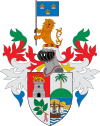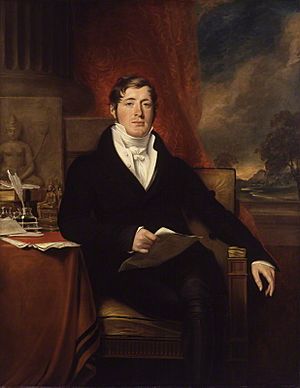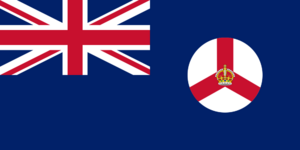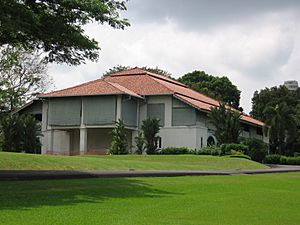Chief Secretary, Singapore facts for kids
Quick facts for kids Chief Secretary of Singapore |
|
|---|---|

Coat of arms of the Straits Settlements
|
|
| Style | The Honourable |
| Residence | Sri Temasek (1869–1959) |
| Appointer |
|
| Term length | No fixed term |
| Precursor |
|
| Formation | 1867 |
| First holder | Ronald MacPherson |
| Final holder | Edgeworth Beresford David |
| Abolished | 1959 |
The Chief Secretary of Singapore was a very important government job in Singapore for many years. This role was also known as the Colonial Secretary of Singapore before 1955, and the Colonial Secretary of the Straits Settlements before 1946. It existed from 1867 to 1959.
This official was second in command only to the Governor of Singapore. The Governor was the top leader in the colonial government.
The Straits Settlements included Singapore, Penang, and Malacca. They became a British colony in 1867. The Colonial Secretary job was created to help manage Singapore. During World War II, when Japan took over Singapore, the job was put on hold.
In 1946, Singapore became its own colony, separate from Penang and Malacca. So, the Colonial Secretary's duties focused only on Singapore. The name changed to "Chief Secretary" in 1955. This happened when Singapore started moving towards ruling itself. The job ended in 1959 when Singapore became self-governing.
The Chief Secretary was in charge of the Colonial Secretary's Office. They were also a special member of important government councils. The Chief Secretary worked at the Empress Place Building. Their official home was Sri Temasek, right next to the Governor's house.
Contents
History of the Chief Secretary Role
How the Job Started

The British Empire began to expand into the Malay Peninsula in the late 1700s. In 1819, Sir Stamford Raffles set up a trading post in Singapore. He appointed William Farquhar as the first leader of Singapore. This was the start of Singapore's colonial history.
In 1826, the British formed the Straits Settlements. This group included Singapore, Penang, and Malacca. They did this to manage trade better. The leader in Singapore was then called the Resident Councillor. The main Governor for the Straits Settlements was based in Penang.
Later, in 1832, the Governor's office moved to Singapore. This made the Governor the top official in Singapore. The Straits Settlements were first managed by British India. In 1867, the British government decided to rule the Straits Settlements directly. This made it a "crown colony." Ronald MacPherson became the first Colonial Secretary of the Straits Settlements.
The Straits Settlements Period
From 1867 to 1942, 19 people served as Colonial Secretary of the Straits Settlements. This job was different from the earlier Resident Councillor role. The Colonial Secretary had a higher position than the Resident Councillors in Penang and Malacca.
The Colonial Secretary's main job was to manage and coordinate the government. They oversaw things like law enforcement and postal services. This role was similar to other colonial secretaries in the British Empire. The Colonial Secretary was based in Singapore.
In 1896, the British created the Federated Malay States (FMS). The Governor of the Straits Settlements also became the High Commissioner for the FMS. However, the FMS had its own leader, the Resident-General, based in Kuala Lumpur. The Colonial Secretary of the Straits Settlements focused on Singapore and the other Straits Settlements.
When Japan invaded Singapore in January 1942, the Colonial Secretary, Stanley Wilson Jones, was removed. The job was left empty after Singapore fell to the Japanese. After Japan surrendered in 1945, the British set up a temporary military government. They did not bring back the Colonial Secretary job right away. This was because they planned to break up the Straits Settlements.
Changes After World War II
The Straits Settlements were dissolved. On April 1, 1946, Singapore became a separate crown colony. Its Governor restarted the civilian government. Penang and Malacca joined a new group called the Malayan Union. Because of this, the job was renamed the Colonial Secretary of Singapore. Sir Patrick McKerron was the first to hold this new title.
In February 1955, Singapore adopted the Rendel Constitution. This led to the job being renamed the Chief Secretary of Singapore. This change happened as Singapore moved towards ruling itself.
In the 1950s, Singapore made many changes to its government. These changes prepared the country for self-governance. In June 1959, the State of Singapore was formed. The Governor was replaced by the Yang di-Pertuan Negara. The Chief Secretary job was then ended. E. B. David was the last person to hold this position. After this, Singapore's government was led by the new Prime Minister of Singapore and their cabinet.
What the Chief Secretary Did
The Chief Secretary was the highest-ranking official in the government service. They were second only to the Governor. If the Governor was away or the job was empty, the Chief Secretary would often act as Governor.
As the second-highest official, the Chief Secretary led the Chief Secretary's Office. This office was in the Empress Place Building. Many other officials worked there to help with daily tasks. The Colonial Secretariat was also part of this office. However, it was closed after 1955 when the Chief Secretary's powers were reduced.
The Colonial Secretary had more power than the later Chief Secretary. They coordinated and oversaw all government departments. They also helped plan and create important government policies. During the Straits Settlements period, their power extended to Penang, Malacca, and other areas. After 1946, their power was limited to Singapore only.
After 1955, the new Chief Minister and Legislative Assembly were created. Elected ministers took over much of the government. This greatly reduced the Chief Secretary's powers. However, the Chief Secretary still controlled foreign affairs, internal security, defense, and public relations.
The Colonial Secretary and Chief Secretary were always important officials. They were special members of the Executive and Legislative Councils. After World War II, these councils were reorganized. The Chief Secretary remained a special member. In 1955, a democratic election system was introduced. The Chief Secretary, along with the Attorney-General and Financial Secretary, remained the only colonial officials in these new bodies. The Chief Secretary job was abolished in 1959.
The Colonial Secretary had the power to issue warrants to arrest and deport people. These were people suspected of causing trouble. The Chinese community in Singapore called these warrants the "Second Prince's Warrant." This was because they saw the Colonial Secretary as the "second prince" after the Governor. For example, in 1939, a Chinese businessman was deported by the Colonial Secretary for being anti-British.
Who Held the Job
Only British officials held the jobs of Colonial Secretary and Chief Secretary in Singapore. No local people were appointed to these roles. Many early Colonial Secretaries had military backgrounds. Others had worked in different parts of the Straits Settlements.
Later, many came from a special program for colonial officials called "cadets." These cadets were often top university graduates. Famous Chief Secretaries included Edward Lewis Brockman, Richard James Wilkinson, and Andrew Caldecott.
Holding this job could lead to even higher positions. For example, Cecil Clementi Smith and Sir Arthur Young later became Governors of the Straits Settlements. Sir William Goode became Singapore's last Governor. Others became Governors in different British colonies.
The longest-serving person in this role was Sir F. S. James. He served for eight years, from 1916 to 1924. The shortest-serving was Edward Lewis Brockman, who held the job for only a few months in 1911. Ronald MacPherson, the first Colonial Secretary, was the only one to die while in office.
The Colonial Secretary and Chief Secretary earned good salaries. In 1892, the Colonial Secretary of the Straits Settlements earned $10,800 a year. This was the second-highest salary in British Malaya, after the Governor. Their official home was Sri Temasek, which was built in 1869. All officials in this role lived there from 1869 to 1959.
See also
- Governor of the Straits Settlements
- Governor of Singapore
- Chief Minister of Singapore







